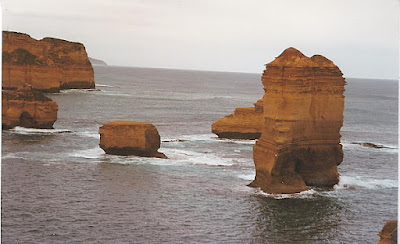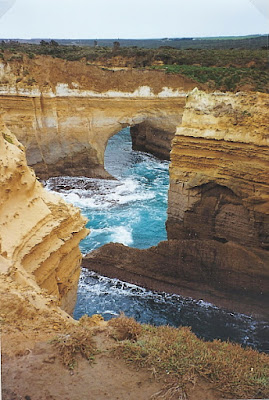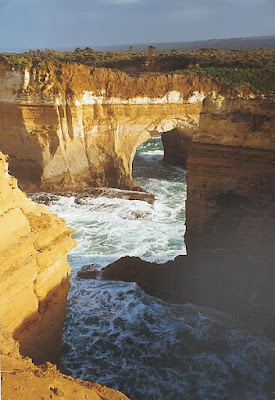The following is the second of four blogs covering a trip John Cooper, Gary Edwards and I made to Australia and New Caledonia in July and August 1998. It is illustrated with prints I took with an old Pentax camera and subsequently digitised. Another account of the trip, including John and Gary's time around Darwin after I had come home, was published in two parts by John Cooper last year (seehttp://jfcbirdingtrips.blogspot.co.uk/2013/04/southern-australia-northern-territories.html). This blog covers Victoria.
Tuesday
28th July. We left Deniliquin soon
after dawn and drove steadily to Chiltern State Forest, arriving there mid-morning. The weather was a slight improvement but it
was still showery, and very cold. We quickly
saw 2 Regent Honeyeaters near Frog’s Hollow and the rest of the day was spent
along Greenhill Road and near Cyanide Dam.
Generally few birds were in evidence although a superb male Rose Robin
was found in a paddock near Greenhill Road.
After dark we drove to Victorian Alps and camped on the lower slopes of
Mount Buffalo.
 |
| Greenhill Road, Chiltern State Forest |
Wednesday
29th July. We awoke to find the tent
covered in a thin layer of snow. It had been cold but I had slept well. Mount Buffalo was closed to vehicles without
chains and we decided to return to Chiltern.
Stopping on the edge of the Alps at Eurobin, near Porepunkah, to check
some parrots flying over (not the hoped for Gang-Gangs) we were accosted by the
owner of an adjacent caravan park who thought we were taking photos of his
property on behalf of an unfriendly rival neighbour! Realising immediately that we were not, and
probably somewhat embarrassed, he invited us look round his park where we were
surprised to see up to 70 non-breeding plumaged Satin Bowerbirds feeding on the
grass, the day’s highlight. We continued to Chiltern and revisited the areas
we’d been to the previous day. After a
few false starts with dark-chinned juvenile Brown-headed Honeyeaters we finally
saw a good Black-chinned but despite much searching we couldn’t find Chestnut-rumped
Hylacola although a perched Collared Sparrowhawk near Cyanide Dam was some
consolation as were a field full of Flame Robins at Brown’s Road. After dark John phoned Mike Carter and
arranged for us to meet him the following morning on the outskirts of
Melbourne. We then drove to Toolangi
(Kinglake National Park) and drove around for almost an hour failing to find
any picnic areas before camping behind the forest centre.
 |
| camping on Mount Buffalo |
Thursday
30th July. We spent the first couple
of hours of light walking in impressive forest at Toolangi but low cloud
obscured the tops of the admittedly very tall trees and the birds were
disappointing, although Bassian Ground Thrush and a Superb Lyrebird were
nice. John drove to Melbourne via
Maroondah Reservoir hoping for Gang-Gangs but one of the workers there told us
they’d not been around for some months. We
met Mike Carter and Des Quinn and after a brief and unsuccessful look at
Ferntree Gulley headed for Lysterfield where Des showed us a superb roosting
Powerful Owl that he kept a regular eye on.
We left Des and moved on to Edithvale where an Australian Bittern was
flushed, Balnaring for a pair of Cape Barren Geese with 4 small goslings and
finally, in a rush to beat the fading light, Rosebud where 3 breeding plumaged
Double-banded Plovers were on the beach.
We returned to Mike’s house in Mount Eliza where he and his wife were
perfect hosts.
 |
| me at Toolangi |
 |
| Powerful Owl at Lysterfield |
 |
| Ferntree Gulley |
Friday 31st
July. We left Mount Eliza after
an early breakfast and drove around Melbourne to arrive at Werribee at 09:00 to
meet Margaret Cameron. She arrived with
Gordon McCarthy and after getting reasonable views of Purple-crowned Lorikeets
by the entrance we were taken on a whistle-stop tour of Werribee. Keeping up with Margaret along the sometimes
slippery dirt tracks around Werribee was an effort at the best of times so her
telling us at one point that we would be heading back the way we’d come in a
‘fairly determined manner’ raised a smile, it was hard to imagine her doing
anything any other way! Birds abounded
at Werribee, the best for us being a very obliging pair of Australian Spotted
Crakes. We then moved on to a flooded
area south of Geelong where a small wintering flock of Orange-bellied Parrots
had been seen regularly. We found them
after a good bit of wandering around, although not before Margaret had to go
(having other commitments), leaving us in Gordon’s capable hands. We then had a quick stop at Laverton
Saltworks (some distant Banded Stilts), Geelong botanical gardens in Eastern
Park (a spectacular flock of Yellow-tailed Black Cockatoos, but still no
Gang-Gangs) and finally a marshy pool and very scenic beach west of Barwon
Heads. A pair of Hooded Plovers on the
beach were superb, but about a hundred dead Fluttering Shearwaters on the tide
line rather depressing. We said goodbye
to Gordon and made for a nearby campsite at Barwon. A phone call to Mike Carter confirmed the
Portland pelagic, scheduled for the 2nd, had been cancelled due to anticipated
bad weather. We had mixed feelings about
this!
Saturday
1st August. We were up at dawn, but
wasted nearly two hours trying, unsuccessfully, to track down a couple of
parrots seen badly in flight. A quick
walk along the beach then failed to produce the Hooded Plovers seen the
previous day. We returned to Geelong via
Drysdale where 3 Blue-billed Duck were seen.
We walked along by the river in Queen’s Park where we found a female
Pink Robin that Gordon had told us about.
It was very nice but again no Gang-Gangs. We drove inland to Brisbane Ranges where we
saw 8 cute Koalas and Marsh Wallabys but few birds and returned to the coast. We immediately saw a Rufous Bristlebird at
Airey’s Inlet Lighthouse and then drove a short way inland to Distillery Creek. Here, finally, our luck turned when two pairs
of Gang-gangs came in to drink at a pool by the car park. They were brilliant (their amazing red floppy
crests were far better than expected) as was an immature male Pink Robin in the
same area. We camped in a campsite near
Airey’s Inlet.
 |
| Marsh Wallaby at Brisbane Ranges |
 |
| eastern Great Ocean Road near Anglesea, the west was to prove much more spectacular |
 |
| Airey's inlet |
Sunday 2nd
August. We left campsite and
tried to find an area of heathland inland from an open cast mine. The dirt track became increasingly muddy and
we gave up but a very tame male Brush Bronzewing beside the road made the
effort very worthwhile. We returned
briefly to Distillery Creek where 2 more Gang-gangs were seen and a small, but
noisy, flock of Forest Ravens flew over.
We continued along the Great Ocean Road where despite showery and dull
weather the scenery was impressive, particularly the 12 Apostles, Loch Ard
Gorge and Bay of Islands. Birds were not
very evident, 6 breeding Black-faced Cormorants being an exception, and those
that were did not always perform as one would like - particularly 2 presumed
Blue-winged Parrots which flew over at cliff top height just at we’d climbed
down to the beach at the head of Loch Ard Gorge! We then hurried along to Warrnambool in time
to see 3 or 4 Southern Right Whales offshore before the light went. We drove steadily north to Little Desert
National Park where we camped.
 |
| Brush Bronzewing giving superb views right by the road, oh for a decent camera and lens |
 |
| easternmost of the Twelve Apostles |
 |
| more of the Twelve Apostles |
 |
| the superb views were in danger of being obscured by coastal fog, a regular occurrence at this time of year |
 |
| Loch Ard Gorge |
 |
| named after an infamous shipwreck |
 |
| the Loch Ard was driven onto the rocks in 1878 killing all but two of the 50 or so on board |
 |
| me on the beach at Loch Ard Gorge |
 |
| rough weather west of Loch Ard Gorge |
 |
| London Bridge, the left hand span having collapsed in 1990 having stranded some tourists on the end |


Monday 3rd
August. We had a quick look
around the Little Desert National Park campsite at dawn then moved on to a
nearby picnic area in a small block of mallee.
Many honeyeaters were present although some took a while to get to grips
with. I eventually saw three that were new (Yellow-plumed, Tawny-crowned and White-fronted)
and some superb male Variegated Fairywrens.
There was a Mallefowl mound near the main track but it was the wrong
time of year for them to be attending it and unfortunately we did not encounter
any. It was just as well it was a small
block of forest as, despite having a compass, I managed to become confused and
disoriented for some time before emerging from a completely unexpected side of
the mallee. We left late morning and
drove to Wyperfield National Park, arriving mid-afternoon. Emus were common, but little was seen along
the Lake Brambruk Track despite a distinct improvement in the weather. Spotlighting along the Eastern Lookout Nature
Drive produced a single Brush-tailed Possum.
 |
| Little Desert National Park |
 |
| Emu at Wyperfield |
 |
| Malleefowl mound at Wyperfield |
Tuesday 4th
August. We spent all day in
Wyperfield National Park, mostly on the trail to the Malleefowl mound and the
first few kms of the Lowan Track. It was
an excellent day with lots of good birds (though not a huge number of species)
and pleasant weather. Highlights were 9
superb Chestnut Quail-Thrushes, Shy Hylacola, Southern Scrub-Robin, Pink
Cockatoo and Mulga Parrot. The only
disappointment was no Malleefowl despite my watching a mound for over 3 hours
although we later learned that they may only visit the mounds once or twice a
week at this time of year. We left
Wyperfield as the light was fading, stopping for food on the way to
Hattah-Kulkyne National Park. We camped
by Lake Hattah under a very bright moon.
 |
| The Lowen Track at Wyperfield |
Wednesday
5th August. It was quite cold by the
lake at dawn, having been clear all night, although a flock of Regent Parrots
soon got the blood racing. We packed
away the tents and spent all day in Hattah-Kulkyne National Park, concentrating
on the mallee adjoining the start of the Nowingi Track. Here Mallee Emuwrens were readily found,
along with Chestnut Quail-Thrush, Crested Bellbird and a distant view of a
Striated Grasswren bouncing away from me.
A drive to Lake Mournpoll produced a superb pair of Pink Cockatoos in
roadside conifers but little else.
Grasswren type calls were heard during a final walk down the Nowingi
Track, but the light was starting to go and nothing could be seen. We returned to camp at Lake Hattah. A Southern Boobook calling near the campsite
shut up as soon as we approached it (another clear moonlit night).
 |
| Nowingi Track, Hattah-Kulkyne National Park |
 |
| Hattah-Kulkyne National Park |
 |
| a rare viewpoint in Hattah-Kulkyne National Park |
 |
| above the high water mark on the shore of Lake Mournpoul, Hattah-Kulkyne National Park. We camped here. |
Thursday
6th August. A ranger told us our best
chance of Malleefowl at this time of year was driving along the roads at
dawn. We tried the Murray Valley Highway
without success. We returned to the
Nowingi Track seeing similar birds, although only one Emuwren and no more
Grasswrens. John failed to reappear at
the car and after some time a very faint shout was heard in the opposite
direction from that to which he appeared to have gone. Gary took a compass bearing and ‘rescued’ a
much relieved John. It transpired he’d
been ‘lost’ for about an hour, at which stage he’d stayed in the same area
periodically shouting in different directions.
The flatness and lack of landmarks in the Mallee clearly required a
greater degree of care than we were taking.
We returned to Lake Mournpoll early afternoon, where a distant
White-backed Swallow was seen, and then concentrated on the track past it to
the kangaroo fence. We’d been told this
was a good area for Chestnut-crowned Babblers and after a couple of hours of
searching eventually found a superb group of 4.
Undaunted by his earlier adventure, John and I decided to have a final
try for the Grasswrens and had brilliant views of a pair along the Nowingi
Track. We returned to camp for a third
night at Lake Hattah. The moon was so
bright the Southern Boobook didn’t even start calling.

 |
| Lake Mournpoul, Hattah-Kulkyne National Park |
 |
| Noisy Miner |
 |
| White-winged Chough |
 |
| the shapes of the trees were superb |
 |
| sunset at Hattah-Kulkyne National Park |
Friday 7th
August. We packed camp and left Hattah
for the drive north to Yarrarra, stopping for breakfast on the way. A couple of hours at Yarrarra produced the
hoped for White-browed Treecreeper and an excellent male Gilbert’s
Whistler. We continued to the border
with South Australia and the fruit check-point.
 |
| sunrise at Lake Mournpoul, Hattah-Kulkyne National Park |
[blogged December 2015]























































No comments:
Post a Comment
Note: only a member of this blog may post a comment.